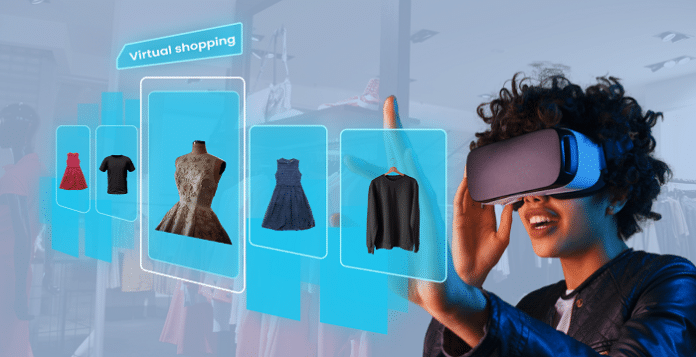Virtual reality (VR) and augmented reality (AR) are changing the face of many sectors as technology develops, and e-commerce is no exception. The retail industry’s virtual reality and augmented reality market was valued at $3.79 billion in 2021 and is projected to grow to $17.86 billion by 2028. AR/VR revolutionising online shopping and completely changing online buying experiences.
E-commerce has undergone a lot of modifications aimed at improving the user experience. Immersive digital retail and interactive virtual shopping experiences are the biggest of them all. It is also experienced that VR usage in eCommerce increases online purchasing conversion rates by 17%. stressing the advantages and difficulties. Let’s examine how virtual reality and augmented reality can affect e-commerce in the future,
What is AR/VR Technology and How Do They Work?
Before exploring how AR/VR revolutionising online shopping, let’s first understand what ecommerce is. Simply put, e-commerce is a process of buying and selling products online. E-commerce platform, on the other hand, is the commerce engine websites employ to record purchases, manage user relationships with online retailers, and handle categorised items.
Virtual reality and Augmented reality in online shopping are two examples of modern technology that are enhancing and transforming digital interactions. By utilising the camera capabilities of a smartphone, tablet, or augmented reality glasses, digital content such as photographs, text, and 3D models may be superimposed over the actual environment. This merges virtual and physical elements, creating a more immersive experience and adding a layer of interactive data.
On the flip side, VR creates an incredibly lifelike simulated experience by rendering computer-generated three-dimensional landscapes that users can explore and interact with. The stereoscopic displays and motion tracking used by virtual reality (VR) headsets like the Oculus Rift and HTC Vive create the illusion that the user is actually there in the virtual world. Entering the digital realm offers boundless opportunities for creativity.
AR/VR integration in retail websites assists in developing interactive and personalised experiences. From furniture placement to virtual try-on, augmented reality and virtual reality transforming e-commerce and creating unique experiences.
How AR/VR Technology are Transforming the Online Shopping Experience?
A virtual try-on for online shoppers is just one example of how these technologies are shaping the future of shopping. Here are some key points on how AR/VR technology is transforming the online shopping experience:
Redefining What is E-commerce
AR and VR are revolutionising e-commerce by blurring the lines between digital and physical realms, redefining what e-commerce is. The best digital commerce platforms are embracing these technologies to create truly immersive digital retail experiences that transcend traditional online shopping.
Virtual Try-on
Augmented Reality (AR) in online shopping is enhancing digital shopping experiences by enabling Virtual Try-On for online shoppers. Customers can virtually visualise products in their real-world environments, trying on clothing and makeup or even envisioning furniture in their homes before making a purchase.
Interactive Virtual Shopping with VR
Virtual reality is transforming e-commerce by creating fully Interactive Virtual Shopping environments. Shoppers can explore Virtual Showrooms, attend immersive product launches, and engage with brands in ways never before possible in traditional e-commerce.
AR/VR Technology in Online Commerce
The integration of AR/VR technology in online commerce is driving an e-commerce revolution through AR/VR. Retailers can leverage these technologies for product demonstrations, virtual consultations, and creating unique, memorable shopping journeys that foster emotional connections with consumers.
Enhancing Engagement and Conversion
E-commerce websites are enhancing online shopping with AR and VR, leading to increased engagement, reduced product returns, and higher conversion rates for businesses. This immersive approach to digital shopping experiences sets brands apart from competitors.
Challenges and Future Developments
Connecting the real and virtual worlds poses its own challenges. AR/VR technology in online commerce can change the way people purchase online. However, these challenges must be rectified and addressed:
Realistic Product Visualisation
- The challenge of creating highly accurate and lifelike 3D model renders and virtual product representations.
- Need for advanced visualisation technologies to meet rising customer expectations.
Cross-Platform Compatibility
- Ensuring consistent AR/VR experiences across various devices (smartphones, tablets, headsets).
- Requires collaboration between hardware and software companies.
Data Privacy and Security
- Concerns around protecting user information as AR/VR becomes more personalised and data-driven.
- Need for robust data security measures and transparency.
Enhancing Immersion
- Future developments in haptic feedback, spatial audio, and scent simulation.
- Further blurring lines between digital and physical for heightened realism.
AI/ML Integration
- Leveraging artificial intelligence and machine learning for personalised AR/VR experiences.
- Data-driven product recommendations and optimised user interactions.
Social and Interactive Shopping
- Incorporating social features for shared virtual shopping experiences.
- Enabling real-time interactions with sales associates and other shoppers.
Conclusion
The emergence of AR-VR technology has clearly benefited the e-commerce sector and the shopping experience for consumers. After desktop and mobile computers, it is the third most common and highly evolved option for online retail sales. With the increasing openness and standardisation of AR/VR, e-commerce enterprises may perform even better by utilising these technologies. The possibilities of AR/VR in digital e-commerce are endless and continuously developing.
If you are intending to build augmented reality or virtual reality mobile apps but aren’t sure where to outsource the work, you can be certain that Mayura Consultancy Services will provide you with top-notch solutions at a price you can afford.
FAQs
How is AR VR used in retail?
Retailers may increase staff productivity and shop performance with the use of VR and AR. Employees at real stores may concentrate on more important duties like marketing and in-person sales in the interim.
How is AR VR used in eCommerce?
Thanks to the use of augmented reality (AR) in eCommerce, customers may virtually try on items like jewellery or clothes and view them as if they were in a real place.
What is AR and VR integration?
Integration of AR and VR unlocks immersive user experiences and helps get the best of both the virtual and real world.
How can I get virtual reality and augmented reality shopping on my devices?
Augmented reality apps and experiences can be run on many current smartphones and tablets with cameras. However, a virtual reality (VR) headset, such as the Oculus Rift, HTC Vive, or Meta Quest, is required for VR.
How safe is it for customers to purchase using AR and VR?
Privacy and security of user data are top priorities for trustworthy platforms. Nevertheless, before making an account, clients should familiarise themselves with the company’s rules and only provide information that they are comfortable sharing.





